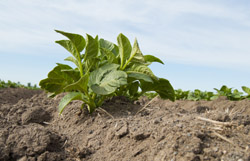Changes in weather impact soil ecosystems
The microbial community is the driving force behind nutrient cycling in the soil and changes in carbon levels. Changes in climate can have an impact on plant physiology, microbial activity and soil nutrient cycling by altering the composition of plants in the ecosystem, photosynthesis and carbon levels. As such, a clearer understanding of how soil microorganisms respond to alterations in precipitation patterns is vital to understanding the impact of climate change on ecosystems. The 'Precipitation pattern effects on plant-soil microbial interactions' (Ppepsi) project is working to enhance knowledge in this area as greater understanding can result in better policies for mitigating the effects of a changing climate. Scientists established a greenhouse experiment and added the non-radioactive isotope Nitrogen 15 to the soil to compare the effect of different precipitation intensity treatments. At the end of the experiment microbial DNA and RNA were extracted from the soil to find which microorganisms were present. Results suggested that frequent precipitation increased formation of carbon bonds between plants and soil microorganisms, but had no effect on plant-microbial competition for nitrogen. Researchers studied a sequence of soils from the Franz-Josef glacier in New Zealand, which were formed over a 22,000 year period. The exceptionally wet climate of the area made it the ideal field site for investigating the relationship between soil microorganisms and very high rainfall. Results showed that soil age is a major driver of bacterial community structure. A third study identified which members of the soil bacterial community act as catalytic converters following the rapid carbon mineralisation that occurs during rainfall. The observed patterns were compared across three Californian grasslands with different climates. Microbial DNA and RNA were extracted from soil samples to determine the composition of the microorganism community. The ongoing work of the Ppepsi project will reveal the response of the plant-soil components of ecosystems to precipitation patterns, focusing on changes in the structure and function of the microbial community. As soil microorganisms drive soil nutrient cycling and soil carbon fluxes, a deeper understanding of the microbial response to precipitation patterns will help to predict changes to vital soil ecosystems.







